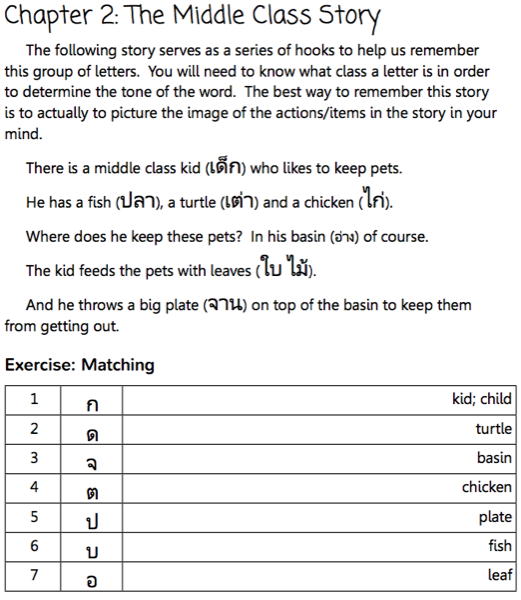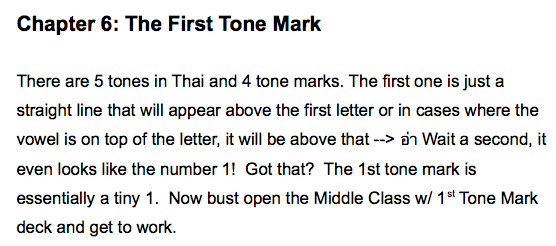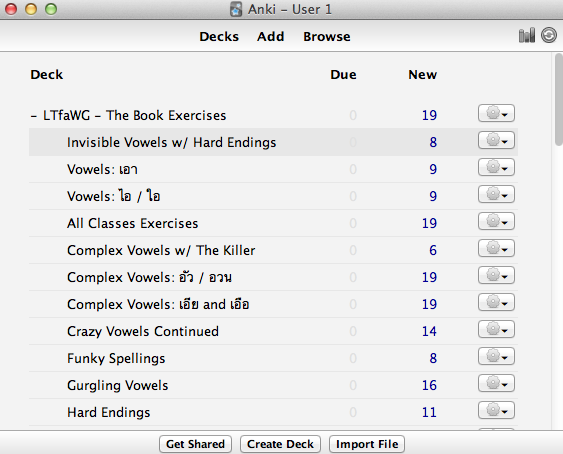It’s no secret that my Thai is embarrassingly bad. I mean, I can get through the day without using English and can usually get my idea across in broken Thai, but after 12 years it should be much better. To put it in perspective, if I met a guy in Canada who had lived there for 12 years and spoke English at the same level I speak Thai, I’d think he was retarded. I could blame it on the fact that every job I’ve had has used English as its operational language, or that every Thai friend I have speaks near-native English, but that would be disingenuous. Fact is, I’ve always been too lazy and/or too busy to really attack it; I have no one to blame but myself. However, recently I’ve decided to get back on the horse and start improving things, and turned to my friend Brett to help me out. Online, he’s better known as the guy behind Learn Thai from a White Guy.
I’ve known Brett for a few years now and he’s one of those guys that inspires you to learn. Not because he spouts some Tony Robbins pseudo-psychology but because the dude taught himself Thai, and when you ask how, he’s totally nonchalant about it. “I just did it. You can too, it’s easy.” After years of fielding questions like this, he finally decided to get his system down on paper and put it together as an e-book, which you can buy for $47 on his website here. No, I’m not getting a cut of anything – I just like his system and thought others might benefit from picking it up.

A surprisingly accurate caricature.
First thing’s first – it’s important to keep your expectations in check – this isn’t some super-secret shortcut to learning Thai like how Neo learned Kung Fu in The Matrix. It still takes repetition, practice and hard work, and it still takes repetition, practice and hard work. And while Brett’s website says you can “learn to read Thai in two weeks” you have to understand the context of “read” – you won’t be picking up some historical Thai literature and flipping through it on your lunch break. But if you stick to the system and practice, you should be able to get a pretty good idea of how the Thai alphabet fits together and be able to pronounce – if not understand – signs, headlines, titles, etc, which is a skill that many foreigners never pick up.
What I like about Brett’s system is that uses mnemonics to plant letters in your head, which is useful for me. Here’s how he teaches you the middle class letters:

Learning the middle class letters.
There’s a little bit more on the page than just that simple paragraph, but after seeing it put like that, bam, I finally had a somewhat elegant structure in my head for remembering the middle class letters instead of just forcing them into the deep corners of my brain.
Another thing I like about Brett’s book is that it’s funny and relatable to a foreigner. The tone is friendly and laid back, and there’s a distinct lack of pretension or stuffiness. Here’s a paragraph on the mai ek, the first tone mark.

Damn you, tone rules, always messing up my pronunciation flava.
The “deck” Brett talks about above is a deck of flashcards called Anki (from the Japanese word for memorize, not to be confused with Enki, the Sumerian god of mischief and creation, but we all knew that). The cards are organized into decks that focus on one particular chapter of his book, as you see below. Used in tandem with each chapter, they are a very powerful tool in helping you to memorize the details of the chapter you’re reading.

Anyway, I’m not a perfect case for the book because I’ve been here long enough that I can sort of read Thai and speak it okay, but going over the drills has sure helped me solidify the tone rules and provide me with an easier way to remember the letters than I was using before. If you want to do some self-guided learning, head over to Brett’s site here to check it out.





Nick is so going to get one of the copy!!
OR you could do what my fluent Thai speaking other Canadian friend did “Learn one word a day and after twelve years…. :)”
Took me 7 years to start getting the hang of it just by listening to people and hanging out with non-English speakers.
Another fellow I know learned Thai very well by spending a year in a Muay Thai camp where no one spoke anything but Thai.
The book sounds easier…
Thanks Big C. I have a friend who moved here 2 months before I did but is fluent in reading, writing and speaking. The big difference is that he moved to a little village in Chiang Rai province for the first year he was here. If he didn’t speak Thai, he didn’t eat.
That’s what I learnt first. Rice, Chicken and water.
When I got sick of eating a pile of rice, a piece of chicken and a bottle of water I learned the individual dishes and of course the numbers.
Next I learnt to fluently insult taxi drivers and drive from the backseat.
Finally I worked on my conversation skills by hanging out with Thais who did not speak much English.
Now I’ve left Thailand I’m glad I didn’t bother to learn too much more. The only times I get to speak is in Thai restaurants and they often don’t care much for me speaking Thai.
Or, you know, you could just spend about one hour with google, writing down all there is to the system, spend some few afternoons with some good old-fashioned copy-paste approach and read the hell out of Thai by the end of the second week^^
If that’s what’ll work, then more power to you, Slowpoke. One of the most frustrating things about the whole process is finding out which of the hundreds of methods works for you. But once you find one, it’s just a matter of sticking to it. Which, at least for me, is a whole other problem. 🙂
Good post Greg and neat language system.
I lived in Thailand for more than 13 years and like you never got fluent. Reason, like you, as embarrassing as it is to say, I’m lazy and never put the hard time in, day after day.
There are methods that work for different people but I think the main way to master Thai or any language, is to decide you are going to do it, put the time in consistently and do it.
Keep up the good writing and posts. You’re doing good work!
What pisses me off the most is that about 11 years ago I started to learn 1 word per day, but soon stopped. If I’d known back then that I’d still be here, I would have a 4,000 word vocabulary. Hindsight is 20/20.
Once you get the hang of the thai letters, try using books that teach thai children. That and a Thai girlfriend:)
Yeah, I heard those are good – especially the ones that have gaps between the words, I think that’ll help a lot. Hopefully. 🙂
I thoroughly enjoyed Bangkok when I went there for the first time this year. I fell in love with it’s culture and the people over the short one week. Thanks for helping me learn Thai! It’s really quite a lot to take in at first, when I tried researching on the script, their pronunciation and the eventually words.
Love reading your blog, keep writing! Hopefully one day I can actually speak Thai and make my “half-thai” claim even more convincing. heh..
Thanks Sam, glad you’re finally getting it. I also find that simply copying how Thais pronounce words is helpful too, for instance 5 is HAA (high tone) and not haa (well, any other tone). I also hate it when people say pat-TAY-ya. It’s PAT-tay-ya, people. 😀
Absolutely horrible for beginners and confusing. Horrible for MAC computer users. He jumps all over the place and it makes no sense. Try Thai lite to learn some phrases and it will make more sense.
Hi Rhonda, no method is perfect for everyone – I know that Brett’s systems has helped many, but if you found something that works well for you, keep at it.
I purchased the course and I now can’t get into my account. And I can’t get in through I forgot my password!!!!!Need help here…
Brett’s on FB if you want to message him there.